|
|
|
Sort Order |
|
|
|
Items / Page
|
|
|
|
|
|
|
| Srl | Item |
| 1 |
ID:
141184
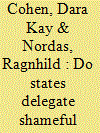

|
|
|
|
|
| Summary/Abstract |
Existing research maintains that governments delegate extreme, gratuitous, or excessively brutal violence to militias. However, analyzing all militias in armed conflicts from 1989 to 2009, we find that this argument does not account for the observed patterns of sexual violence, a form of violence that should be especially likely to be delegated by governments. Instead, we find that states commit sexual violence as a complement to—rather than a substitute for—violence perpetrated by militias. Rather than the logic of delegation, we argue that two characteristics of militia groups increase the probability of perpetrating sexual violence. First, we find that militias that have recruited children are associated with higher levels of sexual violence. This lends support to a socialization hypothesis, in which sexual violence may be used as a tool for building group cohesion. Second, we find that militias that were trained by states are associated with higher levels of sexual violence, which provides evidence for sexual violence as a “practice” of armed groups. These two complementary results suggest that militia-perpetrated sexual violence follows a different logic and is neither the result of delegation nor, perhaps, indiscipline.
|
|
|
|
|
|
|
|
|
|
|
|
|
|
|
|
| 2 |
ID:
141183
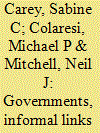

|
|
|
|
|
| Summary/Abstract |
From Syria to Sudan, governments have informal ties with militias that use violence against opposition groups and civilians. Building on research that suggests these groups offer governments logistical benefits in civil wars as well as political benefits in the form of reduced liability for violence, we provide the first systematic global analysis of the scale and patterns of these informal linkages. We find over 200 informal state–militia relationships across the globe, within but also outside of civil wars. We illustrate how informal delegation of violence to these groups can help some governments avoid accountability for violence and repression. Our empirical analysis finds that weak democracies as well as recipients of financial aid from democracies are particularly likely to form informal ties with militias. This relationship is strengthened as the monitoring costs of democratic donors increase. Out-of-sample predictions illustrate the usefulness of our approach that views informal ties to militias as deliberate government strategy to avoid accountability.
|
|
|
|
|
|
|
|
|
|
|
|
|
|
|
|
| 3 |
ID:
141179
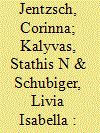

|
|
|
|
|
| Summary/Abstract |
Militias are an empirical phenomenon that has been overlooked by current research on civil war. Yet, it is a phenomenon that is crucial for understanding political violence, civil war, post-conflict politics, and authoritarianism. Militias or paramilitaries are armed groups that operate alongside regular security forces or work independently of the state to shield the local population from insurgents. We review existing uses of the term, explore the range of empirical manifestations of militias, and highlight recent findings, including those supplied by the articles in this special issue. We focus on areas where the recognition of the importance of militias challenges and complements current theories of civil war. We conclude by introducing a research agenda advocating the integrated study of militias and rebel groups.
|
|
|
|
|
|
|
|
|
|
|
|
|
|
|
|
| 4 |
ID:
141180
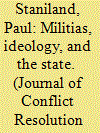

|
|
|
|
|
| Summary/Abstract |
Research on militias portrays them as subservient proxies of governments used to achieve tactical goals. The conventional wisdom, however, ignores the diversity of state–militia relations. This article outlines four distinct strategies that states can pursue toward militias, ranging from incorporation to suppression. It then argues that regime ideology shapes how governments perceive and deal with militias. A new theory of armed group political roles brings politics back into the study of militias. Comparative evidence from India and Pakistan shows that varying regime ideological projects contribute to different patterns of militia–state relations. These findings suggest that political ideas ought to be central to the study of political violence, militias should be studied in direct dialog with other armed groups, and a traditional focus on civil war should be replaced by the broader study of “armed politics.”
|
|
|
|
|
|
|
|
|
|
|
|
|
|
|
|
| 5 |
ID:
141185


|
|
|
|
|
| Summary/Abstract |
In nearly two-thirds of civil wars since 1989, governments have received support in their counterinsurgency operations from militias. Many scholars predict higher levels of violence in conflicts involving pro-government militias because governments are either unable or unwilling to control militias. This article challenges this view, arguing that governments can and do often control militia behavior in civil war. Governments make strategic decisions about whether to use violence against civilians, encouraging both regular military forces and militia forces to target civilians or restraining regular military forces and militia forces from attacking civilians. In some cases, however, government and militia behavior differs. When a militia recruits its members from the same constituency as the insurgents, the militia is less likely to target civilians, as doing so would mean attacking their own community. Statistical analyses, using new data on pro-government militia violence in civil wars from 1989 to 2010, support these arguments.
|
|
|
|
|
|
|
|
|
|
|
|
|
|
|
|
| 6 |
ID:
141186
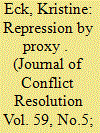

|
|
|
|
|
| Summary/Abstract |
Why do regimes delegate authority over a territory to nonstate militias, in effect voluntarily sacrificing their monopoly over the use of violence? This article argues that two factors increase the probability of states delegating control to a proxy militia, namely, military purges and armed conflict. Military purges disrupt intelligence-gathering structures and the organizational capacity of the military. To counteract this disruption, military leaders subcontract the task of control and repression to allied militias that have the local intelligence skills necessary to manage the civilian population. This argument is conditioned by whether the state faces an armed insurgency in a given region since intelligence, control, and repression are needed most where the state is being challenged. This hypothesis is tested on unique data for all subnational regions within Myanmar during the period 1962 to 2010 and finds that proxy militias are more likely to be raised in conflict areas after military purges.
|
|
|
|
|
|
|
|
|
|
|
|
|
|
|
|
| 7 |
ID:
141181
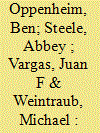

|
|
|
|
|
| Summary/Abstract |
Anti-insurgent militias and states attempt to erode insurgent groups’ capacities and co-opt insurgent fighters by promising and providing benefits. They do so to create a perception that the insurgency is unraveling and to harness inside information to prosecute more effective counterinsurgency campaigns. Why do some insurgents defect to a paramilitary group and others exit the war by demobilizing, while still others remain loyal to their group? This article presents the first empirical analysis of these questions, connecting insurgents’ motivations for joining, wartime experiences, and organizational behavior with decisions to defect. A survey of ex-combatants in Colombia shows that individuals who joined for ideological reasons are less likely to defect overall but more likely to side-switch or demobilize when their group deviates from its ideological precepts. Among fighters who joined for economic reasons, political indoctrination works to decrease their chances of demobilization and defection to paramilitaries, while opportunities for looting decrease economically motivated combatants’ odds of defection.
|
|
|
|
|
|
|
|
|
|
|
|
|
|
|
|
| 8 |
ID:
141182


|
|
|
|
|
| Summary/Abstract |
How do the leaders of nonstate armed groups recruit new members? Most studies of recruitment of combatants focus on explaining the supply of fighters—who fights and what kinds of people volunteer to fight depending on the incentives offered. We know comparatively little about how the leaders of armed groups manage influxes of volunteers to ensure their quality. This article examines the questions of who recruits fighters, and how the capacities of recruiters affect the quality of the individuals who they recruit. The histories of three understudied civil militias in Sierra Leone are used to develop and refine a theory of screening in nonstate armed groups. Evidence from intensive fieldwork suggests that access to civilian information networks can allow the leaders of armed groups to successfully screen recruits and exclude low-quality types even when the pool of volunteers is flooded with opportunists.
|
|
|
|
|
|
|
|
|
|
|
|
|
|
|
|
|
|
|
|
|